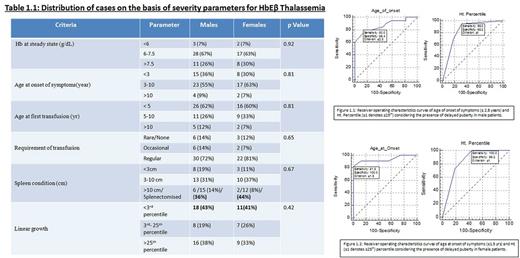Abstract
Background- In India, more than 10,000 new cases of thalassemia are born every year. In Bengal, Eβ thalassemia accounts for more than 50 % of the disease burden. To the best of our knowledge, no published data is yet available on growth, puberty and endocrine complications in these patients.
Aims & Objectives - The aim of this study was to determine the prevalence of growth failure, delayed puberty and pattern of endocrine dysfunctions in patients of Eβ thalassemia. The objectives were to study the correlation between type of endocrine dysfunction with various clinical parameters and serum ferritin levels.
Methods - All demographic details were recorded. Clinical examination, anthropometric measurements and assessment of puberty were done. Routine biochemical investigations and specific endocrinological tests were performed. Patients were put on specific endocrinological treatment and monthly follow up was done.
Results /Conclusions - 69 patients with Eβ Thalassemia were prospectively evaluated. The mean age was 15.6 years. There were 42 males and 27 females (M: F ratio =1.6:1). All patients received oral iron chelation with deferasirox. 23 (33%) of patients had onset of symptoms prior to three years of age while 42 (61%) of patients received their first transfusion before fifth birthday. 52 (75%) patients required regular (>4 units/year) transfusions. 27(39%) of the patients were splenectomised.
29 (42%) of patients were found to have growth retardation. Primary hypothyroidism was present in 9.5% male and 11% female patients. None of the patients were diabetic.
20/42 (48%) male patients had delayed puberty. They had significantly earlier onset of symptoms (p =0.04) and were more frequently growth retarded (p=0.01) in comparison to patients with normal puberty. Receiver operating characteristics (ROC) analysis was employed to find the best cut off values for age at onset of symptoms and Ht. Percentile capable of identifying delayed puberty in HbEβ Thalassemia Patients. With the cut off value of age at onset of symptoms at ≤2.8 years, sensitivity and specificity of the marker was 80% and 86. 4 %. Also, with the cutoff values of Ht. percentile at ≤25 percentile, sensitivity and specificity of the marker was 95.0% and 68.2% in identifying delayed puberty.35% of male patients with delayed puberty achieved puberty with no or short duration (6 months) of testosterone replacement.
11/27 (41%) female patients had delayed puberty. They had significantly (p=0.02) earlier age at onset of symptoms. With the cutoff value of age at onset of symptoms of ≤1.5 years, sensitivity and specificity of the marker was 81.8% and 100 % in identifying delayed puberty. Also, sensitivity and specificity were 100% and 56.2% respectively, with the cutoff values of ≤25 percentile Ht percentile for age. 36 % of female patients with delayed puberty spontaneously achieved menarche without hormonal supplementation.
Serum ferritin was not significantly different in patients with delayed puberty (in comparison to patients with normal puberty).
In this study, different clinical predictors of severity and serum ferritin levels were analysed to study their association with delayed puberty in Eβ thalassemia patients. Similar studies conducted from different centers will help to confirm or negate our findings.
No relevant conflicts of interest to declare.
Author notes
Asterisk with author names denotes non-ASH members.


This feature is available to Subscribers Only
Sign In or Create an Account Close Modal